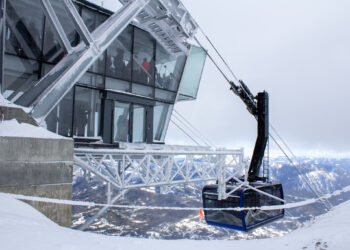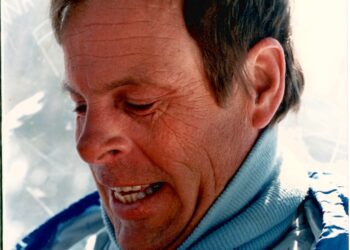By Emily Stifler
I laid on a chiropractic table, on my stomach, and
Dr. Jeff Saad cradled my head and neck in his
arms.
“Everything’s easy. It doesn’t hurt,” he said, then
had me turn my head and dangle my arms off the
table. “No big deal, okay? I got you.” He spoke
with a confident tone, almost teasing.
I’d never been to a chiropractor and was doubtful
and nervous. Saad, a Doctor of Chiropractic, had a
reputation for being very effective.
“Just a little pressure here,” he said and put a
hand on the back of my neck.
Crack.
“You okay with that?” he asked.
I assessed. Everything felt fine.
“Could you do this wrong?” I asked. “Do damage?”
“It’d be difficult, but I suppose so. You don’t pay
me for what I do, you pay for what I don’t do,
based on a history and examination,” he said. In
an effort not to aggravate an existing problem, he
watches for symptoms, signs, concerns or trauma.
“This is where your tension headaches come
from,” he said, pointing to specific spots on my
cervical spine.
I don’t have tension headaches, I thought, still
doubtful.
I flipped onto my back, and he bear hugged me.
“Lift your head, give me a big breath, blow it
out,” he said. “One more time. Good.” When I let
go my breath, he cracked my back.
“How are you doing now?” he asked.
I assessed again. That one hurt…or did it? Maybe
it just felt weird.
He joked about rusty hunting knives and surgery,
then re-arranged my legs and leaned against me,
using his body weight to adjust my lower back.
“Are you having fun yet?” he asked.
—-
“It’s been a great ride,” Saad said about his job. “I
enjoy it very much, and I’ll do it ‘til I’m a little
old man.”
Originally from Minnesota, Saad earned a degree
in human biology at Northwestern University,
then a Master’s at Northwestern College of Chiropractic.
He’d enrolled in med school but dropped out
when he broke his rib on a ski vacation at Bridger
Bowl. He went to an M.D. “and he didn’t do a
thing,” Saad said. Next he saw a chiropractor who
“adjusted, maneuvered and manually pulled together
the two separated pieces of bone,” putting
them back in place. Saad was sold.
The self-described “resort junkie” practiced in
Vail for seven years and also worked with athletes
on the New York Mets and the Dallas Stars. Now
41, Saad has been in Big Sky a decade, lives at
Moonlight and is here to stay. His 6-year-old son
Benji is in first grade at Ophir School.
Before adjusting me, Saad asked about my medical
history, did a full assessment and checked my
reflexes, just like a Western doc would. I told him
about my injury laundry list – knees, back, ankle,
shoulders, neck, wrist – and that nothing really
hurt now, other than regular aches and pains; I
was there out of curiosity, mostly.
That status fit right into Saad’s health mantra:
management over time.
“Nothing is good forever,” he explained. “You’re
constantly fighting the laws of gravity, injury,
athletics. That’s why management over time is
the only way. That means getting adjusted, getting
massage – over time, five or six times a year.
We can’t protect you from everything, but we can
stop a lot of it.” He wants people to understand
and protect their bodies because, “it’s yours, you
keep it for life.”
Every muscle has a receptor that senses stress,
pressure or pain, according to Saad. But “that
sensory info can get muddled. When you get
adjusted I’m trying to get your sensory, motor,
and nervous systems firing so the information is
processing properly.”
“You have 26 moveable bones in your spine, and
they need to be moving,” Saad explained. “When
they’re not, there’s a problem. When it goes for
too long, there’s a bigger problem.” That’s where
regular manipulation helps.
And it’s all connected, he said: “If your knees are
bad, your back starts to hurt. What started out as
a primary knee problem becomes a primary back
problem. It’s all links in the chain – your ankle,
your knee, your hip, your low back, all those
joints in your back, to your neck. I can make a
case for headaches being caused by big toe pain –
over time, not overnight.”
In the world of medicine, “we all have our place,”
he said. “I’m not doing surgery on your knees,
and we’re not curing cancer. I’m just re-setting
the bones and releasing some gasses from the
joint capsule.” The divide between chiropractic
and Western medicine, has “been a long battle
over turf that’s been beaten down over the years.
Results are the key to success.”
—-
Still doubtful, I called my father, a pediatrician.
He has friends who are chiropractors, has seen a
chiropractor several times in the last couple years,
and even had a medical student work in his office
that was also a chiropractor. He said he’d seen
manual manipulation work well for neck and back
pain.
But there hasn’t been as much evidence-based
research into other aspects of chiropractic because,
unlike the prescription drug industry, the
profession profits without the research. So while
some of the ancillary work chiropractors do may
work, much of it is untested in the eyes of Western
medicine.
Besides, the point is to help you feel better, he
added. If it works, who cares about the research?
“The proof is in the pudding.”
Wanting to know more, I called Dr. Jesse Coil, a
Doctor of Osteopathy with the Medical Clinic of
Big Sky. D.O.’s like Coil have full medical training,
plus training in hands-on work.
“Manipulation is difficult to scientifically prove
because you are relying on patients describing
how they feel after treatment, which is very subjective,”
Coil said.
He suggests it’s a short-term fix that can help people
feel better. But if “a couple days later you’re
sitting in the same position at a desk, the problem
returns. Unless you’re fixing the base problem,
usually manipulation is a temporary fix.”
However, manipulation, Coil said, has never been
proven to do any harm.
“There is a place for manipulation and helping
correct musculo-skeletal problems, but I don’t
think it can replace medicine.”
—-
Saad adjusted my feet, “tightened” my knees, and
“reactivated” my muscles. It was a minor session,
he said, but I’d needed the overhaul. He’d noticed
tightness in my upper neck, my low-and mid-back
caused by posture. I’d be sore, but everything
should feel good soon. If I needed, I could come
back for a 20-minute follow-up.
I was sore for a couple of days – not muscle sore,
just a little off. Then when I relaxed, I felt looser,
freer and lighter. In a couple of weeks I started
feeling like I needed to go back. Like my spine
was… stuck. It was something I’ve felt before but
hadn’t put a word to – until Saad planted the idea
in my head.
So am I hooked? Is my phobia cured? I haven’t
been back yet, but I’m sure thinking about it.













